In modern conditions, more than 300 parasitic infections are known. Microorganisms that excite them and helminth worms enter the human body to use its resources, as well as scabies mites and lice that live on the skin and hair.
Sometimes parasitic diseases are almost asymptomatic. However, many infections can have serious consequences: parasites disrupt metabolism, poison the body and destroy tissues and organs. Some parasites pose a deadly threat. For example, malaria, an infection transmitted by malaria mosquitoes, kills more than 600, 000 people each year.
In our country, from 1 to 2 million cases of parasitic diseases are recorded annually, but, according to doctors, the number of people infected with these infections is actually several times higher.
According to the World Health Organization, 4. 5 billion people suffer from parasitic infections, more than half of the world's population. The main contributors to these sad statistics come from countries with hot climates, as well as regions with low levels of hygiene and a shortage of clean water. Residents of these places face dangerous diseases such as malaria and schistosomiasis. A disease caused by parasitic worms. Symptoms appear in tropical and subtropical regions. In case of complications, they affect the liver, kidneys, bladder fibrosis and infertility. Filariasis. Infection caused by parasites transmitted by the bites of tropical insects. Leads to the destruction of the lymphatic system. In our country, as in countries with temperate climates, the problem of parasitic infections is not so acute: here the most common are 18-20 parasitoses, which are easy to treat and have a favorable prognosis.
Types of parasitic diseases
Diseases caused by protozoan microorganisms are divided into three main categories: infections caused by amoebae, trichomonads and leishmania.
Also, depending on the stage of the disease, acute and chronic parasitic infections are distinguished, as well as by localization - intestinal and extraintestinal, when parasites penetrate and multiply in various tissues and organs: lungs, muscles, liver, kidneys, but not in the intestines.
Let's take a look at the most common diseases in our country.
Diseases caused by protozoan microorganisms
Giardiasis
The body is infected by intestinal lamblia (Giardia intestinalis, Giardia lamblia), which are transmitted through contact with contaminated fruits and vegetables, water or everyday objects. They stick to the walls of the small intestine and feed on leftover food. Symptoms of giardiasis include abdominal pain, diarrhea and constipation, nausea, vomiting, general weakness and insomnia.
Amoebiasis (amoebic dysentery)
The most common causative agent of this disease is the dysenteric amoeba Entamoeba histolytica. Infection occurs via the fecal-oral route. Microorganisms can survive for a long time on various surfaces, in water, on vegetables, fruits and meat. Typically, amoebiasis manifests itself as severe diarrhea (often mixed with blood and mucus), nausea, and mild fever. If microorganisms enter the bloodstream and spread to the liver, lungs and brain, this can lead to the formation of a liver abscess (formation of a pus-filled cavity), respiratory failure andsymptoms of encephalitis.
Diseases caused by helminths
Enterobiosis
The most common disease is ascariasis - it accounts for up to 70% of all cases of parasitic infections. Almost every resident of our country has faced this at least once in their life. Ascariasis is caused by roundworms - roundworms. Askaris eggs can enter the body through dirty hands; they persist for a long time on food and various objects with which an infected person has come into contact. These parasites cause nausea, abdominal pain, sleep problems and itching in the anus.
Ascariasis
Worm infection is caused by roundworms (Ascaris lumbricoides). Their larvae enter the body through vegetables and fruits, as well as through interaction with contaminated soil. A person infected with ascoriasis loses their appetite, has a stomach ache and nausea appears. With many of these parasites, problems with permeability of the intestines or bile ducts can occur, disrupting the digestion process and the flow of bile.
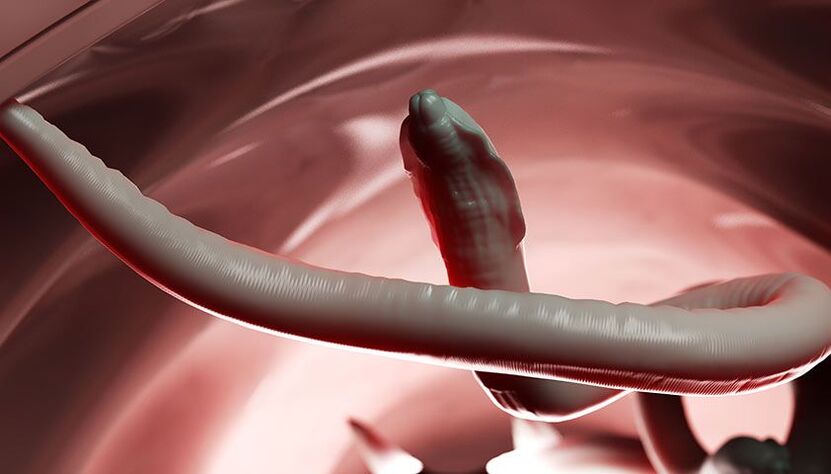
An adult roundworm can reach a length of 25 to 30 cm
Toxocariasis
The cause of the disease is the roundworm Toxocara canis, which is transmitted to humans via the fecal-oral route. In most cases, infection occurs without symptoms, because Toxocara canis larvae do not develop into adults in the human body. However, as they move through organs and tissues, they can disrupt their normal functioning. As a result, a person may experience unreasonable coughing and difficulty breathing if the respiratory system is damaged, neurological disorders if the brain is damaged, allergic reactions and anemia. In extreme cases, the infection can lead to vision deterioration or even complete vision loss.
Echinococcosis
Echinococcosis is caused by the parasitic worm Echinococcus, which lives in the bodies of some animals and is transmitted to humans. Inside the human body, worm larvae form cysts in the liver, kidneys, lungs and even in the brain. This can lead to serious complications - anaphylactic shock, increased intracranial pressure, development of abscesses, pathological changes in organs and tissues - and lead to premature death.
Opisthorchiasis
If you eat poorly fried or lightly salted fish from the carp family, you can get opisthorchiasis. These fish are often infested with larvae of flatworms of the genus Opisthorchis, which damage the bile ducts of the liver, pancreas and gallbladder. Symptoms of the disease include excessive sweating, allergic skin rashes, fever, abdominal pain, nausea, vomiting, and inflammation of the upper respiratory tract.

Fish specialties can become sources of parasites
Diseases caused by arthropods
Scabies
One of the most common skin diseases is lice, caused by a microscopic mite Sarcoptes scabiei var hominis. These mites are spread through contact with an infected person, burrow into the skin, migrate and lay eggs, causing itching and rashes. Pediculosis can lead to serious complications related to the appearance of a secondary infection.
Scabies
Bad torment on the skin and hair, an infection that often comes from head lice (Pediculus humanus capitis). This parasite attacks the host by sucking blood. The saliva of the lice, entering the wound following the bite, causes extreme itching. Pediculosis leads to the appearance of eczema and conjunctivitis: by scratching the bite spots (yes, they can also be found on the eyebrows, eyelash line), a person can transfer pathogenic bacteria into the resulting wounds, those which lead to infectious complications. In addition, lice carry an extremely dangerous infection: typhus.

Ordinary hygiene is not an infallible guarantee against infection by lice: they live in healthy hair as well as in dirty hair.
Signs of parasite infestation
Most often, parasitic infections, which are very widespread in our country, most often manifest with minimal symptoms or signs similar to those of intestinal infections and poisoning. A person infected with parasites experiences loss of appetite, abdominal pain, occasional bouts of nausea and vomiting, unexplained weight loss, and general deterioration in health and weakness. An increase in temperature, the appearance of a rash and other allergic reactions, iron deficiency anemia and minor disorders of the nervous system (increased excitability, sleep problems) are also possible.

Parasitic diseases are often confused with poisoning, intestinal infections and acute respiratory viral infections.
Often the signs increase or decrease, making diagnosis difficult. In most cases, parasitic infections are discovered accidentally during preventive examinations or when diagnosing other diseases.
Complications due to parasites
As a rule, parasitic infections common in our country rarely lead to serious complications. However, with a significant number of parasites in the body, over time a person's health condition can seriously deteriorate.
The most common complications of parasitic infections:
- obstruction of the intestines and bile ducts,
- abscess of internal organs,
- sepsis,
- peritonitis,
- intestinal inflammation,
- inflammation of the upper respiratory tract,
- anaphylactic shock.
Parasitic diseases in children
70 to 90% of cases of parasitic infections affect children and adolescents. Indeed, children tend to be less hygienic and more active in exploring the world around them. Children are often diagnosed with polyinfestations, when they are infected with several types of parasites, for example, enterobiosis associated with ascariasis or giardiasis. If a child is infected with one type of worm or protozoan, their immunity is weakened, making them more vulnerable to other types of parasites and infections.
Parasitic infections cause serious harm to the child's body: its protective functions are disrupted, the child does not feel well, his mood often changes, and his academic performance decreases. It is therefore recommended to take regular parasitosis tests to prevent the most common infections.
Which specialist treats parasitic diseases?
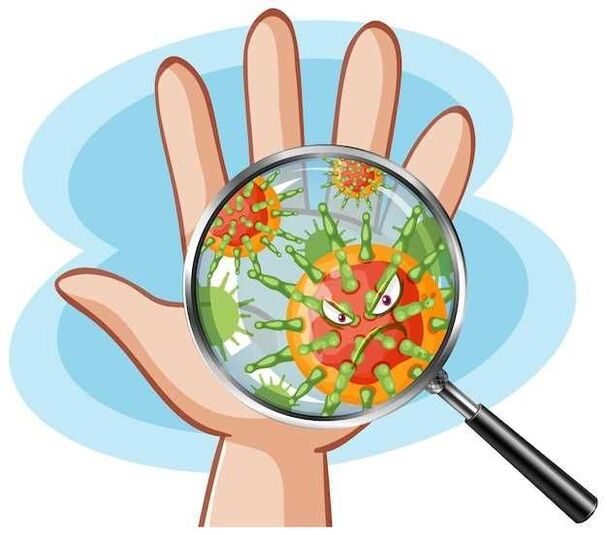
Signs of parasitic infections can be confused with symptoms of a cold, allergy or intestinal infection. If you suspect the presence of parasites, it is important to contact your general practitioner who will be able to assess your symptoms, prescribe the necessary tests and, if necessary, refer you to a parasitologist or infectious disease specialist.
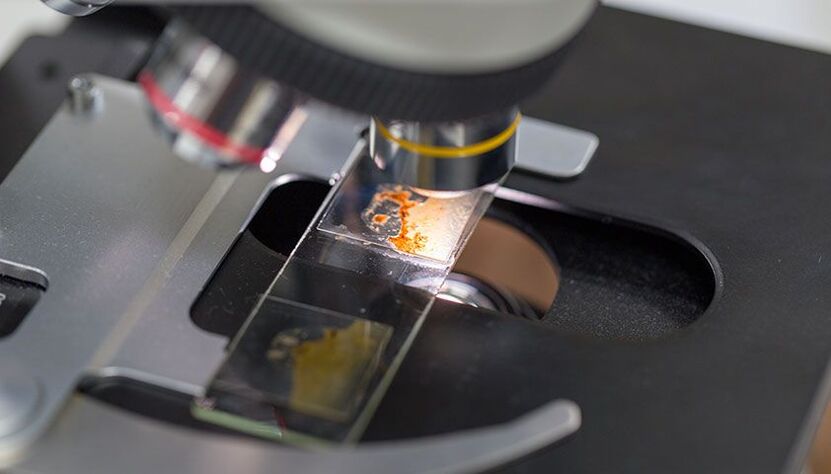
It is especially important that children are regularly tested for parasitic diseases to avoid possible complications.
If parasites have been present in the body for a long time and have seriously affected health, consultation with specialists in other fields of medicine may be necessary. For example, in cases of echinococcosis, it is often necessary to consult a surgeon to surgically remove the cysts formed by helminths.
Perform laboratory tests to diagnose parasitic diseases
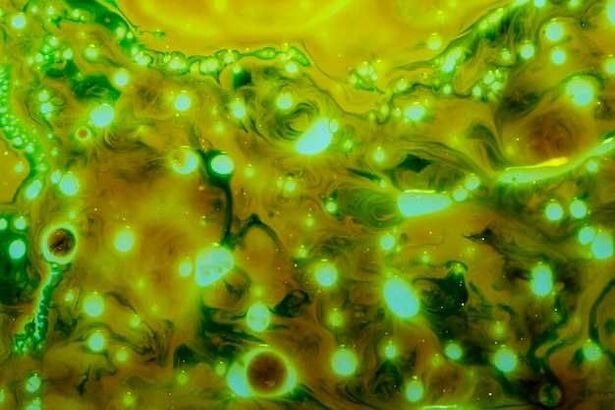
Most parasitic infections can be successfully detected through testing. By studying the composition of the blood, we can identify the presence of antibodies that the body produces in response to the invasion of foreign parasites. Examination of stools and smears can detect parasite eggs and larvae.
However, it must be taken into account that parasites have their own development cycle (from egg to adult) and that in the early stages of infection, tests may not detect the presence of parasites. To ensure reliable results, it is recommended to perform some tests twice with an interval of 7-10 days.
Methods for treating parasitic diseases
When the diagnosis is confirmed by a doctor, he or she prescribes antiparasitic medications, which are generally taken over several days to several weeks. Symptomatic treatment can also be prescribed - antipyretics for fever, drugs for diarrhea and absorbents for gastrointestinal disorders, immunomodulators to maintain immunity.
After completing treatment, it is recommended to re-test to ensure treatment effectiveness and full recovery.
Measures to prevent parasitic diseases
The main reasons why parasites enter the human body are dirty hands, contaminated water and food. In order to prevent the development of infections, it is important to follow hygiene rules: wash your hands regularly, carry out wet cleaning in the house, carefully handle fruits and vegetables and wear protective gloves when workingin the garden. Meat and fish should be boiled, fried or baked until cooked. Undercooked dishes and raw smoked or lightly salted treats can become a source of parasites.
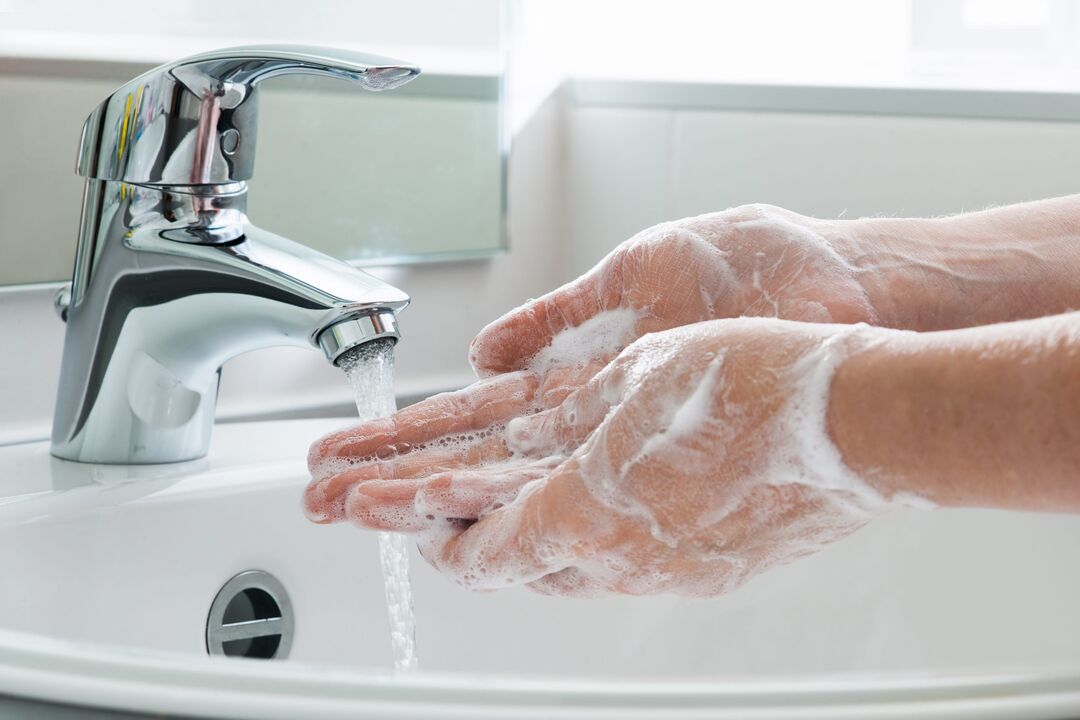
To prevent parasitic infections, it is important to practice good hygiene
Everyone, especially children and adolescents, should be tested regularly for the most common parasitic diseases to detect possible illness early.
Before traveling to tropical countries, you should consult a doctor and learn about measures to prevent exotic parasitic infections, which are rarely encountered in our country. Treatment of these infections is usually more difficult, complications develop more often, and diagnosis is difficult due to the lack of experience of doctors.
Home methods to get rid of parasites
Parasites, these unwanted guests of our body, can cause many unpleasant diseases. They can cause allergic reactions, disrupt digestion, and even affect your mental state. Fortunately, there are effective ways to combat pests right in your home.
One of the most popular methods to get rid of parasites is to use natural products such as garlic, ginger and walnuts. Garlic, thanks to its antiparasitic properties, can help fight parasites and strengthen the immune system. |
Additionally, you can resort to herbal decoctions and infusions. Herbs like tansy, yarrow and clove are known for their antiparasitic properties and can help cleanse the body of parasites. |
Don't forget good hygiene. Washing your hands regularly before eating, peeling vegetables and fruits before eating and handling meats before cooking are basic precautions to avoid parasitic infestations. |
Parasites as a cause of allergic reactions
When exposed to parasites, the human body may begin to develop allergic reactions to these pathogens.
Parasites can cause allergies in travelers in areas with an increased risk of helminth infection.
Protection against parasites when traveling is an important aspect of health, since the possibility of infection can lead not only to a deterioration in general health, but also to the development of allergic reactions.
Protection against parasites while traveling
When we travel, especially to hot countries, it is important to keep in mind the possible danger that parasites can pose. The presence of parasites can harm our health and cause various problems. It is therefore necessary to take measures to protect against this.
There are many ways to protect yourself from parasites while traveling. One of the main ones is to monitor the quality of drinking water and food, since parasitic infections are most often transmitted through them. It is also worth considering the location of the hotel and taking measures to prevent insects and ticks.
When traveling to exotic countries, you should always consult a doctor and take malaria prophylaxis, as mosquitoes can carry this dangerous disease. It is also recommended to use insect repellents and disinfect personal hygiene items.
Harm caused by parasites to women's health
Parasites can seriously harm women's health, causing various problems and complications.
Parasites can lead to digestive disorders, allergic reactions, chronic fatigue, malaise and other unpleasant consequences for the female body.
The fight against parasites in women requires special attention and an integrated approach to avoid serious health consequences.
Question and answer:
What parasitic infections can occur in humans?
To date, more than 300 parasitic infections are known, caused by single-celled organisms, helminth worms, arthropods and other parasites.
How do parasites enter the human body?
Parasites can enter the human body through contaminated drinking water, food, insect bites, contact with infected animals or other people.
What symptoms can occur if you have a parasitic infection?
Symptoms of parasitic infections may include gastrointestinal upset, weakness, fatigue, weight changes, allergic reactions, itching, and skin irritation.
What precautions should be taken to avoid parasitic infections?
To prevent parasitic infections, it is necessary to maintain hand hygiene, avoid eating raw or undercooked foods, carefully monitor the purity of water, and take protective measures against insects.
How are parasitic infections treated?
Treatment for parasitic infections depends on the type of parasite and may include taking antiparasitic medications, antibiotics, symptomatic treatment, and other methods prescribed by a doctor.
What types of parasitic infections can enter the human body?
Today, more than 300 types of parasitic infections are known, caused by single-celled organisms, helminth worms, arthropods and other parasites.
On which organs and tissues of the human body can parasites live?
Parasites can live in the intestines, liver, lungs, blood, and other organs and tissues of the human body, using them as a source of nutrition and resources for survival.














